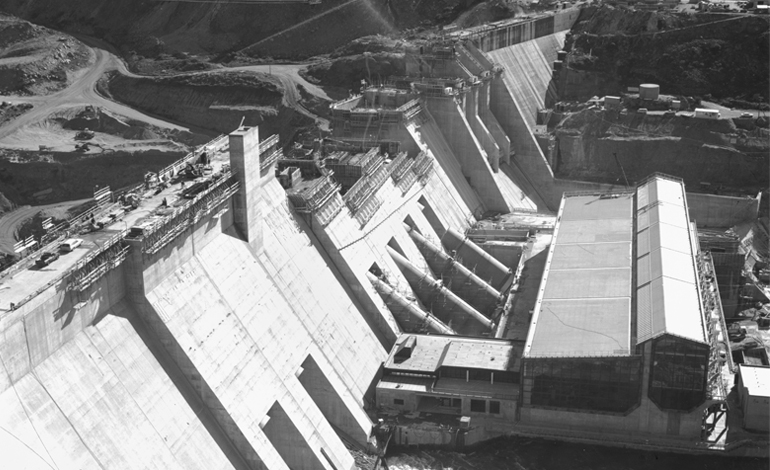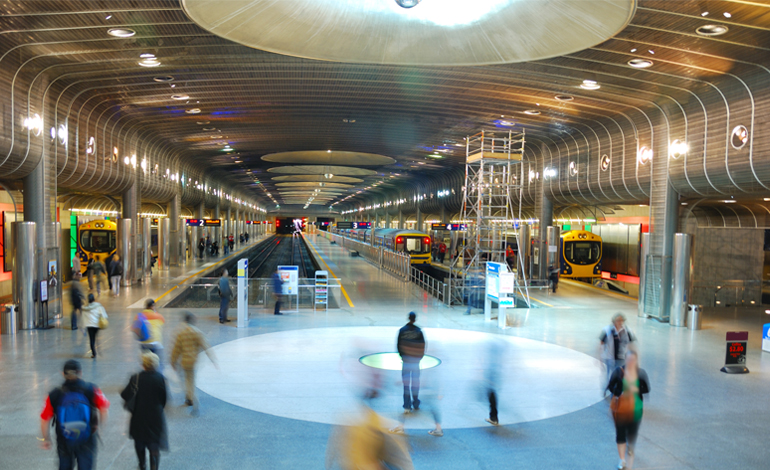Infrastructure New Zealand chief executive Stephen Selwood has an eye on the future. As the organisation heads into its 14th annual symposium, he talks with Ruth Le Pla about how infrastructure decisions should be made and delivered, and about strengthening the role of regional government.
When Stephen Selwood tells me he’s hungry for change, it’s nothing new. I’ve enjoyed long, wide-ranging conversations with him for years. He’s invariably generous with his time and not a bit harrumphy when I poke and prod him on his views.
Like many others he’s got his main messages. I’ve lost count of the number of times he’s done his ‘now is the hour’ spiel on me. We both laugh when I remind him that last year was the same. And the year before that.
So, it’s no surprise when he launches this latest series of chats with “we’re on the cusp of a major change in New Zealand about how we plan, fund and deliver infrastructure”. Then, as usual, he goes on to say this necessitates a long hard look at the role of various central and local government agencies.
This time around, though, there’s a more personal vibe to the conversation. After 14 years at the helm of Infrastructure New Zealand (INZ), Stephen is stepping down in search of pastures new.
Building Nations – Building Regions
The Infrastructure New Zealand Building Nations Symposium 2019 will be held at the Energy Events Centre, Rotorua, from August 21 to 23. Now in its 14th year, the symposium typically attracts 600 or so attendees. This year’s get-together will focus on ‘Building Regions’ – how to position the regions for growth, fund investment and tackle the challenges facing the water, housing and transport sectors. For more details and to register go to bit.ly/Infrastructure_BuildingNations
Stephen hasn’t just been INZ’s long-standing CE: he’s been it’s only one ever. The group’s chair Andrew Stevens credits him with turning “an idea for a new business advocacy group” into “one of New Zealand’s most respected thought leadership organisations”.
Andrew might well say that: as chair, that’s his job. But there’s plenty of evidence to back up his assertions. (See the box story What a difference 14 years makes.) More to the point, Stephen has done all this in an affable manner that, as much as possible in our changing times, builds consensus rather than division. That’s no mean feat.
Meanwhile, Andrew has just announced that former BNZ general manager of institutional banking Paul Blair will pick up the reins from Stephen later this month.
Paul used to be on the INZ board so will be well able to straddle the huge array of sub-sectors that form part of our country’s infrastructure landscape.
Stephen will stay on at INZ to see it through its annual powwow, this year being held in Rotorua from August 21 to 23 (see box story Building Nations – Building Regions).
He tells me he’s got his eyes set on “some sort of role” in the new NZ Infrastructure Commission. Announced by Infrastructure Minister Shane Jones back in August last year, this autonomous Crown entity is in the throes of being established.
Once up and running, it will be charged with working with central and local government, the private sector and other stakeholders, to develop a nationwide 30-year infrastructure strategy.
Stephen says he hopes he can make a contribution there and to broader governance in the sector.
“My heart and soul are in the public sector and lifting New Zealand’s performance,” he says, “so I’m looking at governance roles and, potentially, CCOs and central government agencies that are largely in the infrastructure world.”
Look to the regions
This year’s symposium bears down on the role of the regions and plays right into ongoing conversations about the possible future role of local government. Hand-in-hand with that, inevitably, comes talk about funding and financing.
INZ plans to launch a paper at the symposium proposing change to our country’s planning system, local government structures and local government funding.
It will also front up with research based on findings from its most recent international delegation. This latest one was to Singapore, Hong Kong, Beijing and Shanghai. The previous one hit Switzerland, looking into that country’s version of localism. It’s interesting to note that Oliver Hartwich, one of the champions for the adoption of localism in our country, will be speaking at this year’s INZ symposium too.
Here’s where INZ’s focus on the regions kicks in. “In our view, regional government needs to be strengthened,” says Stephen. “At the moment, regional councils are largely environmental regulators with a bit of a transport policy bolt-on. District councils are, obviously, the investors and the planners at the local level. But you don’t see coherent regional social and economic development plans.”
He concedes that some regions such as the Waikato and Bay of Plenty are very active in that regard. “But often you find that regional spatial plans, for example, struggle for want of funding and consistent support from district council subsidiary members.”
Stephen says INZ sees a “real opportunity” for the Provincial Growth Fund to provide an incentive for change and growth at the regional level, “rather than take the piecemeal approach that has been adopted to date”.
He argues that a centralised fund could be used to incentivise the regions to develop credible long-term plans. Regional entities – he reckons 10 to 15 would be a good number – would identify the infrastructure and other investment needed to support those plans and use the fund to contribute towards their delivery.
All of which leaves local councils to focus on improving local democracy and placemaking.
“If more local government rates funding could go to local community issues – with greater funding at the regional level for the more macro issues – there’s an opportunity to reconcile the localism view with the regionalism view and then you have alignment between national, regional and local government.”
Stephen sees as unhelpful discussions that make rural New Zealand square off against urban zones. He argues we should be promoting an understanding that the cities are vital to the productive hinterland of the provinces and, equally, the hinterland is vital to the future well-being of the cities and the very reason that they exist.
“How can we think in a more holistic way rather than in a provincial / local way about harnessing the benefits of both? That’s where I think the more regional approach is beneficial. It encourages, and in fact enables, that wider, more strategic, discussion that is getting lost in the local debates right now.”
What a difference 14 years makes
Infrastructure New Zealand (INZ) first saw the light of day as the NZ Council for Infrastructure Development (NZCID). Formed in late 2004, it had just 16 foundation members. Stephen Selwood its first – and, until now, only – chief executive was recruited in March the following year.
“I recall the then-chairman saying, ‘Stephen, we’ve got enough money to pay your salary for about six months’,” he says. “He told me if I liked the job and wanted to carry on, I’d have to join up some more members. That’s how we started. It was an entertaining first year.”
INZ now has 140 memberships: all corporate after a brief flirtation with individual memberships brought little value to the organisation. Stephen says current members “pretty much” represent a who’s who of the sector.
The group switched its name to INZ about three years ago: a move that Stephen describes as “transformational”.
“Instantly, people know what you stand for. It’s so much easier for the media, and particularly the public, to understand. It’s been a major reason for our strong growth and increasing influence as an organisation in recent years.”
Stephen says NZCID was always a difficult name anyway. “When you went overseas and said you were from the New Zealand CID, people thought you were from the police. When you spoke locally, people often said, ‘oh, you’re from a council’. To be frank, there was just utter confusion.”
Chair Andrew Stevens credits Stephen with, among other things, helping kick off the process for governance reform in Auckland and RMA reform nationally, and his long hard fight for the creation of an over-arching New Zealand Infrastructure Commission.
Stephen pays tribute to the staff at INZ who, he says, all “own” and are very committed to their roles. “We only have six people now and for many years it was just three or four.”
His pick of their collective milestones to date?
Placing infrastructure on the political map
Back in the early 2000s, infrastructure was only thought about when it failed, says Stephen. That had followed decades of under-investment, particularly in transportation infrastructure. At times, electricity supply was on the margin with dry lakes and problems getting powerlines and transmission even to our largest city, Auckland.
“We got to a crisis point where we had delayed infrastructure investment for so long that it was starting to really hurt. So, we wanted to stand up and put infrastructure on the nation-building agenda.”
Shifting the political horizon to longer-term thinking
Infrastructure planning has been extended from three years to a 10- or even 30-year horizon. “That’s always been our mission,” says Stephen. He adds that INZ is delighted to see the NZ Infrastructure Commission – which will focus on a 30-year infrastructure strategy – now finally formed. “It’s taken too long but it’s great that it’s here.”
More money for transport infrastructure
“We managed to influence government thinking about a significant lift in transportation investment,” says Stephen. He cites as examples the shift to full hypothecation of the fuel tax across to transport and investment in Roads of National Significance (RoNS).
RMA fast-track
Changes have been made to resource management legislation to allow projects of national significance to be called in, considered and approved within nine months. Previously this could take years.
Auckland’s SuperCity
The formation of a single council in Auckland was mission-critical to the city’s future success.

This article was first published in the August 2019 issue of NZ Local Government Magazine.

